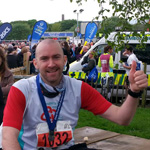This time last month I shared the ups and downs of running my first marathon. On Monday, four weeks after my adventure in Manchester, I ran the Belfast Marathon.
Those of you who read my article last month will know that my first marathon was full of disappointment and frustration. After training well for many months, I pulled my hamstring just a month before the marathon. This meant that I could not do any training in the lead up to the marathon.
In the actual race, I struggled to breathe, experienced fever throughout the race, and ran with a large swollen foot. A few days later I would be told at the hospital that I had caught cellulitis a few days before the marathon. To say the least, this was bad timing.
Belfast was a chance for me to make amends for the frustrations I experienced in Manchester. Let’s look at how I got on.
Preparing for the Race
With only four weeks to prepare, and a hamstring injury hindering me, I was not able to prepare properly for Belfast.
In the first week, I was on antibiotics to clear up the cellulitis. In the following week, I attempted to run. For the first mile or two, my foot was in agony due to the swelling that my foot still had (though the doctor confirmed cellulitis was cleared). After a few miles, my hamstring was in a lot of pain.
I managed to do six miles that day. That was a mistake. Even though I was walking around mostly pain-free, my hamstring hadn’t healed. It would be the last time I would run before the Belfast marathon.
A pain-ridden six mile run is not really good practice for a marathon, but I tried to make the most of it. I climbed a local hill called Tinto a few times, as I knew Belfast was a little hilly. I also went out to my gym and hit my punch bag. While this doesn’t really help with endurance, it was getting my heart rate up.
Five days before the Belfast marathon, I did a walk up Tinto Hill (or as most people here call it, Tinty). It’s a steep hill, so it really gets your heart rate going. I did the walk without any pain, which gave me confidence that I would be good in Belfast.
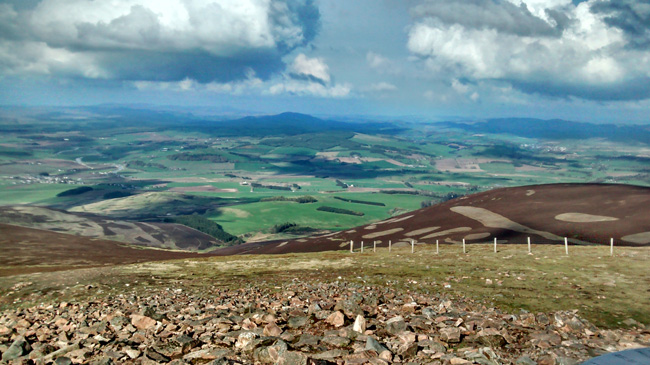
The following day, I did another punchbag workout in my gym. I also did some light stretching. I believe it was this, and not climbing Tinto Hill, that made me hamstring injury get worse again. In future, I am going to avoid stretching it until it is fully healed.
I was still in pain with my quad and hamstring right up to the marathon itself. Obviously, I was disappointed. However, I was not as dejected as you would have thought. I had originally pulled my hamstring at the start of March and have never allowed it to heal.
After my hamstring pull flared up again, I was strangely at peace with it all. I had already paid for my flight to Belfast, I had already paid for my hotel, and I had already paid for the event itself. Therefore, I had nothing to lose by running. I honestly didn’t know if I could run a mile, three miles, or more. My plan was just to turn up and give it a try.
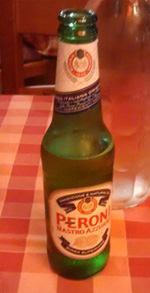
Belfast is a city I have been to many times as my brother lives there. He moved over there to work at Queens university several years ago and I usually get over at least once a year. The city is very like Glasgow and is only a short twenty five minute flight from Scotland.
The night before the race, my brother came out and met me and my friend Barry. We went out to an Italian for some dinner. My friend Barry had two pints of Guinness to “help him sleep”, so I decided to treat myself to a beer.
I probably only slept about four or five hours on the night before the race, however I felt great in the morning and was ready to run.
One thing that had changed from my last marathon was carb loading. I had pasta for two nights before the race, however I did not go out of my way to eat a ridiculous amount of carbs. In hindsight, I probably could have ate a little more carbs, but on the whole I felt much better by not carbing up.
The Race
Our hotel was only a few blocks away from the start of the race. I walked to the event with Barry at around 8am; powered by the two slices of bread and jam I had for breakfast.
In the hour before the race we walked around, handed our bag in, and used the toilet. I took an ibuprofen at around 8:30am so reduce the pain in my hamstring.
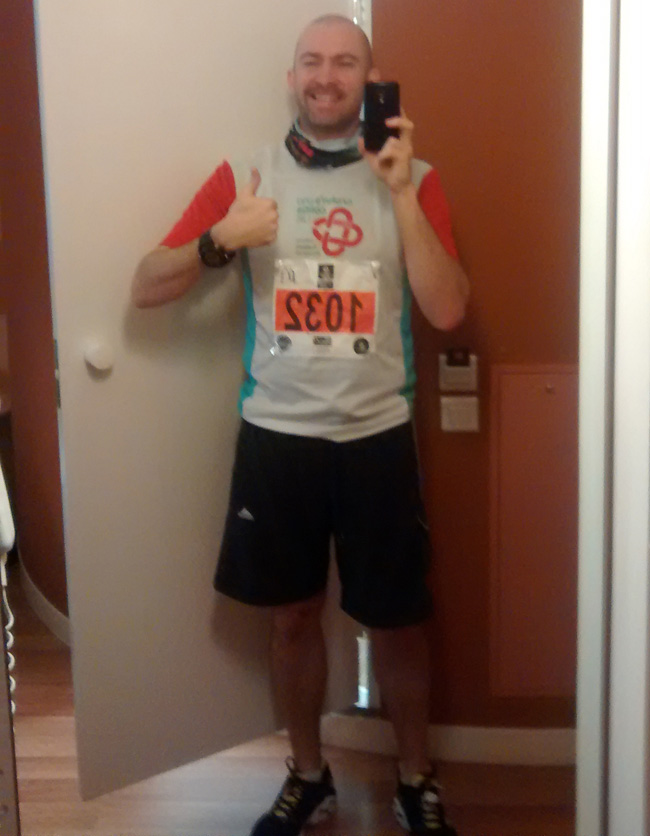
The event started at Belfast City Hall; a beautiful building that would not look out of place in any European city. There were a few tents set up by charities, but by and large there were not many things to see and do beforehand.
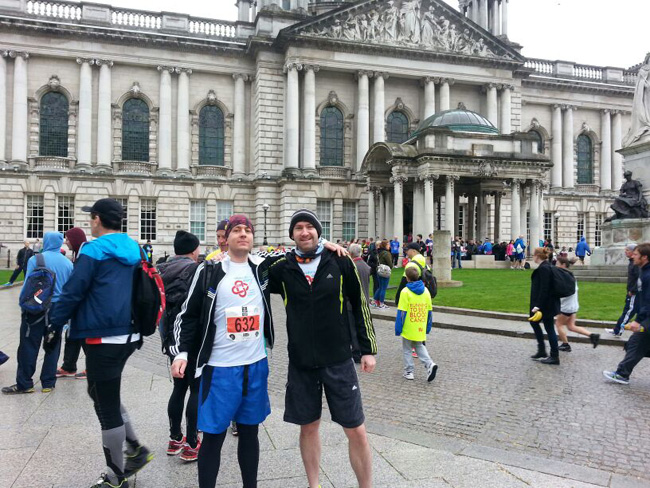
There was only around 2,500 people running the marathon itself, however far greater numbers were running in a relay that allowed up to five people to complete the marathon together.
Marathon runners were placed at the front. This meant that I was much closer to the front than when I ran Manchester marathon.
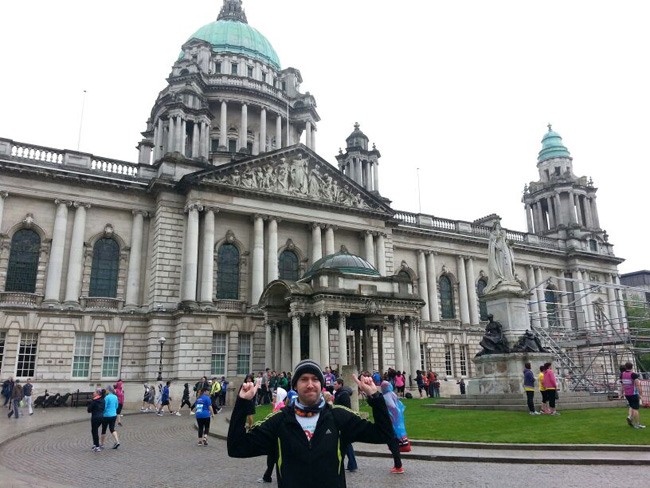
At 9am, the horn fired off and we all started running. This was the first time I had run since I strained my hamstring again three weeks earlier, and I honestly didn’t know if I’d last the first mile.
Thankfully, it was not as bad as I expected. I had a lot of pain in my quad and hamstring during the first two miles, though the pain was not as severe after two miles. My lungs heated up around this point too, so I was able to breathe easier.
My pace was around 8:45 to 9:00 minute miles in the first five miles. Then we stepped it up a little to around 8:30 minute miles. We had reviewed the elevation of the marathon beforehand and knew that from around mile seven to around mile fifteen, we had to climb up around 350 feet.
When we got to the hill, I consciously dropped my pace so that I would not burn myself out (you burn much more energy going up hills). As I had been injured, I hadn’t really had an opportunity to do hill training. My friend Barry moved ahead, though I did not want to put any pressure on my hamstring or burn myself out, so I just stuck to my slower pace.
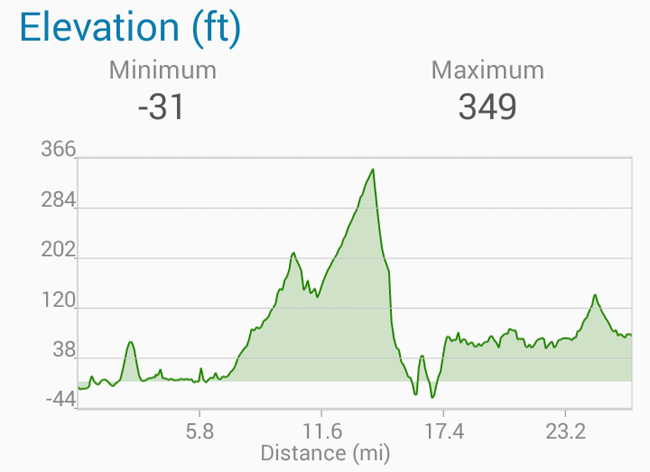
The rain started lashing down during the hill, though I was pacing myself really well. Around the middle of mile fourteen, I reached the highest point. As I started moving down the hill, I felt my heart rate decreasing. I also made a quick stop at the woods at the side to do a pee (needs must!). Taking a break from running, even for just twenty seconds, helped my heart rate go down even more.
My heart rate was about five to ten beats per minute slower going down the hill, despite running at a much faster pace. This illustrates how much effort can go into hill running.
Despite running uphill for half of it, I managed a time of around 1:56 at the half marathon point. I had tons of energy left, there was a downhill part to run, and there were no major hills left. Therefore, I felt confident of breaking the four hour mark.
Running down the hill was almost euphoric. With my heart rate dropping and an energy gel pulsing through my blood, I felt confident of not only finishing the marathon, but doing it in a good time.
Sadly, it was not to be.
Around mile fifteen, my right leg cramped up badly. It was impossible to run at the same pace as I had before. I struggled on, however my pace continued to get worse as I got further into the race.
At mile eighteen, we moved onto a lane that lay besides the motorway. For a mile or so, the wind and rain from the Irish sea hit my face hard. Running in the rain had not been an issue going uphill, but by this point my clothes were wet and cold. I noticed how bad it was when I reached around to get a gel and struggled to unzip the bag as my hands were shaking. Once we got to a place where there were trees stopping the wind, I warmed up and felt good again.
Around the same time, I was keeping pace with the four hour pacemaker. I knew that I had to keep running beside him to break a four hour marathon. While my lungs felt good, after a few miles I could not physically keep going at the same pace. I felt like my quad and hamstring muscles could pop at any time and did not want to make it any worse. At this point, the goal changed from breaking the four hour mark to simply finishing the race.
I did not want to stop during the race. Perhaps my legs would have felt better if I had stopped for a second and stretched; however I was concerned that if I stopped, my legs would simply cramp up even more. So I plodded along.
The rest of the race was just about making it to the end. I was not really testing my lungs, though my legs felt stiffer with every mile. My right quad, hamstring, and calf, all pulsed as if they were about to pop. A hill around the twenty three mile mark did not make help things either.
Thankfully, I did manage to finish the race.
I completed the race in 4:06:59, while my friend Barry completed it in an impressive 3:49:21.
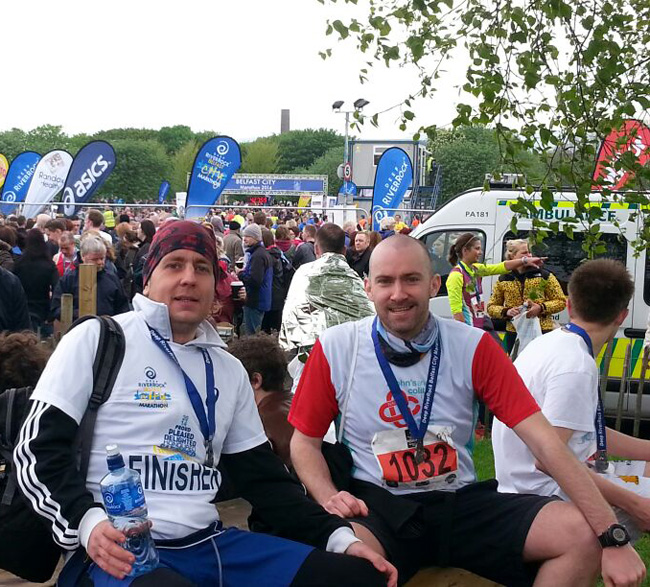
It was strange crossing the finishing line. In Manchester, I was exhausted; the most exhausted I had been in my life (due to the fever). In Belfast, I finished the race and felt like I could have ran another five miles (that is, of course, if my legs could have lasted!).
Finishing with so much left in the tank illustrates that I did not need to exert myself over the last eight miles. It obviously makes me wonder how I would have done if I my quad and hamstring had not went at mile fifteen. I believe I would have been around four or five minutes slower than my friend Barry; perhaps a time of 3:54 or 3:55.
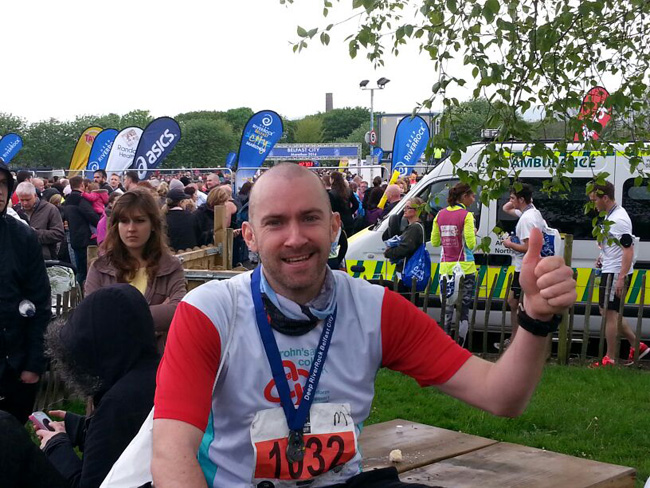
The table below shows how much my pace dropped after mile fifteen. You can see that my average pace was around 10:15 during miles twenty one to twenty three. This dropped to around eleven minute miles when I reached the final hill.
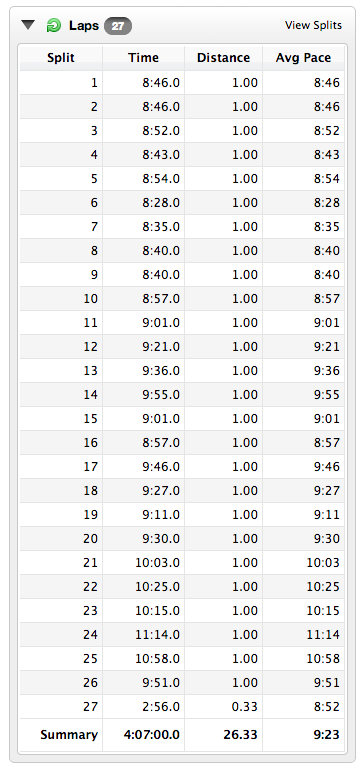
All in all, I am happy that I finished the race. Again, I faced a lot of frustrating problems in preparation and in the event itself.
I did not manage to break the four hour mark, but when I consider that the previous day I did not know whether I would even manage to run two miles, I cannot be disappointed.
The Belfast Marathon
After two marathons in a month, I would like to class myself as a veteran.
OK, I’m clearly still wet behind the ears, however I do have one marathon behind me which I can compare the Belfast marathon to. All in all, I think the event was run well, though there were a lot of little things that were frustrating.
The first issue is water stations. In Manchester, the water stations handed out plastic throwaway water bottles that you could grab and keep running. They were not perfect as they tended to shoot the water right to the back of your throat; however they allowed me to run with water in my hand throughout the race.
Belfast gave out water in polystyrene cups instead.
When you tried to run with a cup of water, it inevitably just fell out the cup. Trying to drink it while running was impossible too. I did this once or twice and only managed to get a small mouthful. The rest simply fell on the ground.
This was a pain in the ass for a number of reasons.
Firstly, it meant that I could not run with a bottle of water, something that I liked to do in Manchester as it allowed me to take a drink whenever I wanted; rather than trying to force down as much as I could whenever a water station appeared.
Secondly, it meant that I could not take energy gels when I wanted. The energy gels I use need to be taken with water. Unfortunately, the water stations were not always when I needed, or wanted, to use a gel.
All of this meant that I had to physically stop at each water station and take a drink. Anyone who runs will tell you that when you are running well, you don’t want to stop.
They offered bottles at some locations towards the end of the race. It makes me wonder why they didn’t offer this from the start. In future, I am always going to take a bottle of water with me at the start of the race.
Another problem was gel stations. At Manchester, there were many gel stations. In Belfast, there were only two: one around mile sixteen and another a few miles later (I cannot recall where). Thankfully, I took eight gels with me anyways, though it would have been a pain if you had ran the race with the expectation of there being more (I only ended up using six).
Another thing that was annoying was the relay stops. Racing next to relay runners was a little annoying at times.
From the very start, relay runners would rush past us. A mile or so later, we would see many of them standing by the side catching their breath. They would then run faster at the end to finish strong. This was annoying at times.
For example, as we approached the motorway, there was a small lane that only had space for two or three people in a row. One young runner sprinted past me and another runner so hard that he pushed us away. I then saw him do it to other people. Thankfully, most people were not as ignorant as him. Around mile twenty two, I passed two girls who were simply walking and talking on their phones. That was more bizarre than anything else. I imagine their friends would have been annoyed with them after they had given it everything.
I have nothing against the relay runners personally and I have admiration for people who do not exercise taking on the challenge of running five or six miles in an event. However, I felt it was badly organised.
The end of the first relay mark is a good example of this. You ran through the relay point and all the people crowded the street on both sides. The stewards did not keep people back so people were crossing right in front of runners. People moved forward so much that you could only fit one or two runners in a row; and it was not possible to overtake the people who were stopping.
It was so bad that Barry was shouting at everyone to move out the way as it was forcing him to slow right down to a snail pace.
Collectively, I believe these relay points added another minute or so to every marathon runner’s time due to slowing down and not being able to overtake. It was a problem that I just did not have to deal with in Manchester.
There was also a point where a steward waved relay runners one way and marathon runners another and the steward advised me and a few other runners to go the wrong way before quickly changing her advice. I imagine this was just a slip of the tongue more than anything else.
The end of the marathon could be improved too. At the end of the Manchester marathon, we were given bananas and a bag that had an energy bar in it. In Belfast, we were giving a bag that contained a packet of 99 calorie crisps, a packet of porridge, and some sort of granola topping for yoghurt.
Unfortunately, I had forgotten to take a bowl and milk with me during my marathon. I will never learn!!! ;)
Clearly, these items were provided by sponsors, however I think it is quite poor to only offer a marathon runner a packet of 99 calorie crisps after they have just burned around three and a half thousand calories.
These issues obviously did not detract from the enjoyment of the marathon. Despite these issues, and the problems with my right leg, I managed to finish and had a great day.
The Problem with My Leg
I was at the physio today regarding a long standing issue I have with my neck. She saw me limping and asked if I wanted to focus on my leg a bit more. Obviously, I said yes.
After performing a series of stretching exercises, she determined that I have not pulled my hamstring. I actually have piriformis syndrome. The piriformis muscle is located deep inside your buttock, making it quite literally, a pain in the ass!
Here’s how Wikipedia explains it:
Piriformis syndrome occurs when the Sciatic nerve is compressed or pinched by the Piriformis muscle. Indications include sciatica (radiating pain in the buttock, posterior thigh and lower leg) and the physical exam finding of tenderness in the area of the sciatic notch. The pain is exacerbated with activity, prolonged sitting, or walking. The diagnosis is largely clinical and is one of exclusion.
Prolonged sitting….exactly what you want to hear when you sit at a desk all day!
The physio said that the muscle will definitely flare again if I do Edinburgh in seventeen days, but she gave me a series of stretching exercises to complete every day. At the moment, the pain is quite bad, however I can feel a good stretch when I do the exercises. My friend Paul had this problem too and said that he tried chiropractor’s, but he healed quickly after performing these exercises. So I am hoping that this all turns out to be good news.
Onwards and Upwards
It was a struggle for me to walk after the marathon. I still managed to make it out to watch the football and have a few beers, though at the back of my mind was the realisation that I have probably made my long lasting leg problem even worse.
The next day was not any better. I continued to struggle up stairs one step at a time, which seemed to frustrate the old lady behind me as I hobbled onto the plane (a little ironic). For the rest of the day, my legs were in a lot of pain. At home, I reverted to sliding downstairs on my ass as it was too difficult to walk down.
Thankfully, as I awoke yesterday morning, my legs felt a lot better. I was able to walk better and my legs felt less cramped. I still have tightness in my legs, though I am hoping that it will clear before the Edinburgh marathon.
Sadly, time is not on my side. Edinburgh is only seventeen days away and I still have pain walking, never mind running. Realistically, I am not going to be in a position to train before the marathon.
This means that following the Edinburgh marathon, my last four runs will have been 26.2 miles, 6 miles, 26.2 miles, and 26.2 miles. Kind of bizarre when you think about it. Maybe running marathons exclusively is the way forward :)
Edinburgh was always the marathon that I wanted to run as it is local. There are four or five of us running the main marathon and many more of my friends that are running the half marathon. It is going to be a great day and I don’t want to miss it.
The Edinburgh marathon is also one of the fastest races in the UK. There is a slight hill near the start and then it is downhill for a few miles and then flat for the rest of the race. My hamstring struggled with the long hill in Belfast, and it was the cause of my legs seizing up, so I am hoping that a flatter race will allow me to get a much better time.
Until then, I need to just play the waiting game and do my best to recover as best as I can. Time to cross my fingers again.
Kevin

